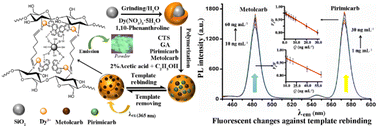Dy(iii)-coordination imprinted self-assembly microspheres based on a silica core for highly sensitive and selective detection of two carbamate pesticides†
Abstract
Carbamate (CB) pesticides possess potential carcinogenic and mutagenic activities towards humans even at very low dosages. Thus, broad-specificity probes with high sensitivity and speed are needed for multiple CB determination. This study is the first to focus on Dy3+ ions-coordinated self-assembly on a silica core using a surface imprinting procedure, for the simultaneous fluorometric detection of residues of metolcarb (MC) and pirimicarb (PC) insecticides. A simple and mild solvothermal method was applied for the preparation of fluorescent imprinted microspheres starting from 1,10-phenanthroline (Phen)-ligated Dy3+ ions to guide imprinted self-assembly of chitosan (CTS), glutaraldehyde (GA), and two carbamate pesticides (MC and PC) on the silica surface by means of coordinate bonds and hydrogen bonds. The as-prepared microspheres displayed strong fluorescence emissions via the antenna effect derived from the Phen ligand and the Schiff base oligomers for sensitizing the Dy3+ ions. An expanded in-depth mechanism study was performed on the fluorescence enhancement involving Förster resonance energy transfer (FRET) from the pesticides (donor) to the acceptor. A linear increase in fluorescence at 483 nm for MC and 574 nm for PC upon the imprinted microspheres was observed under the same 350 nm excitation wavelength. Moreover, the quantitative recognition process could be carried out simultaneously and tolerate strong distractions both from five other similar carbamate insecticides and from complicated matrices (e.g., an extract of Chrysanthemum morifolium Ramat). The detection limit was 4 ng mL−1 with a range of 10–60 ng mL−1 for MC and 0.4 ng mL−1 with a range of 1–30 ng mL−1 for PC. Further characterization of the material, including TEM, SEM, XPS, and FTIR, Raman, and fluorescence spectra, verified that the Dy3+ ions play a decisive role in promoting imprinted self-assembly around the silica core. Hence, a novel polynuclear Ln–organic imprinted probe having high selectivity, stability, and sensitivity for the detection of two carbamate insecticides is presented in this study.



 Please wait while we load your content...
Please wait while we load your content...